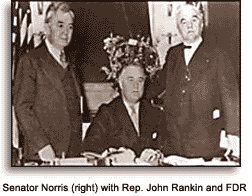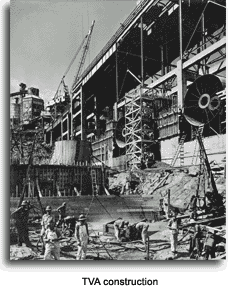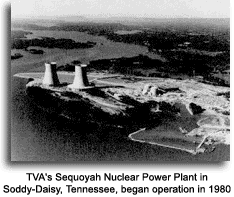The story of the Tennessee Valley Authority starts with Muscle Shoals, a stretch of the Tennessee River where the river drops 140 feet in 30 miles. That drop in elevation created the rapids or "shoals" that the area is named for and made passage farther upstream impossible. The federal government acquired the land in 1916, with the intent of constructing a dam that would generate electricity needed to produce explosives for the World War I effort, but the war ended without a dam being built.
 In the following years, efforts were made to sell the land back to the private sector. Senator George W. Norris of Nebraska fought to keep the land in public ownership, but his efforts to have it developed were defeated by the resistance of Republican administrations. Calvin Coolidge vetoed one bill in 1928 and Herbert Hoover vetoed another in 1931:
In the following years, efforts were made to sell the land back to the private sector. Senator George W. Norris of Nebraska fought to keep the land in public ownership, but his efforts to have it developed were defeated by the resistance of Republican administrations. Calvin Coolidge vetoed one bill in 1928 and Herbert Hoover vetoed another in 1931:
The real development of the resources and the industries of the Tennessee Valley can only be accomplished by the people in that valley themselves. Muscle Shoals can only be administered by the people upon the ground, responsible to their own communities, directing them solely for the benefit of their communities and not for purposes of pursuit of social theories or national politics. Any other course deprives them of liberty.
The election of Franklin D. Roosevelt altered the balance of power and finally led to action. On May 18, 1933, President Roosevelt signed the Tennessee Valley Authority Act, as part of the flurry of legislation that marked Roosevelt`s first 100 days in office.
The TVA pledged to improve navigability on the Tennessee River, as well as provide flood control, reforest and improve marginal farm land, assist in industrial and agricultural development, and assist in the creation of a government nitrate and phosphorus manufacturing facility. The TVA was one of the most ambitious projects of the New Deal in its overall conception.
The TVA encountered many setbacks and failures and was involved in many controversies, but it brought electricity to thousands of people at an affordable price. It controlled the flood waters of the Tennessee River and improved navigation, as well as introduced modern agriculture techniques.
 The Tennessee Valley, which drains the Tennessee River and its tributaries, includes parts of seven states: Tennessee, Kentucky, Virginia, North Carolina, Georgia, Alabama, and Mississippi.
Prior to the Tennessee Valley Authority Act, the region was one of the most disadvantaged in the South. The TVA was given an assignment to improve the economic and social circumstances of the people living in the river basin.
The U.S. Department of Agriculture, including the Agricultural Adjustment Administration, U.S. Forest Service, Civilian Conservation Corps (CCC), and 1state agricultural experiment stations and extension services, were (and are) among the agencies that have worked with the TVA to carry out a well-rounded program of rehabilitation for both the land and its people.
Direction, dissent, and dams
The TVA was first presided over by a three-member board who held differing ideas about the direction the TVA should take. Arthur Morgan was an advocate of social planning, who saw in the TVA an opportunity to build a partnership between government and business. Morgan believed the higher purpose of the TVA was to eliminate poverty in the Tennessee Valley and to act as a model for national regional planning.
Harcourt Morgan supported southern commercial farmers and was suspicious of experiments in government planning. David Lilienthal was an outspoken promoter of public power who wanted the TVA to compete directly with private power interests. A battle between the three administrators went on from 1933 until March 1938, when President Roosevelt dismissed Arthur Morgan for his public criticisms of the TVA.
The Tennessee Valley, which drains the Tennessee River and its tributaries, includes parts of seven states: Tennessee, Kentucky, Virginia, North Carolina, Georgia, Alabama, and Mississippi.
Prior to the Tennessee Valley Authority Act, the region was one of the most disadvantaged in the South. The TVA was given an assignment to improve the economic and social circumstances of the people living in the river basin.
The U.S. Department of Agriculture, including the Agricultural Adjustment Administration, U.S. Forest Service, Civilian Conservation Corps (CCC), and 1state agricultural experiment stations and extension services, were (and are) among the agencies that have worked with the TVA to carry out a well-rounded program of rehabilitation for both the land and its people.
Direction, dissent, and dams
The TVA was first presided over by a three-member board who held differing ideas about the direction the TVA should take. Arthur Morgan was an advocate of social planning, who saw in the TVA an opportunity to build a partnership between government and business. Morgan believed the higher purpose of the TVA was to eliminate poverty in the Tennessee Valley and to act as a model for national regional planning.
Harcourt Morgan supported southern commercial farmers and was suspicious of experiments in government planning. David Lilienthal was an outspoken promoter of public power who wanted the TVA to compete directly with private power interests. A battle between the three administrators went on from 1933 until March 1938, when President Roosevelt dismissed Arthur Morgan for his public criticisms of the TVA.
 In October 1933, construction began on Norris Dam, named after Senator Norris, who had campaigned for the TVA`s creation. The TVA engaged in one of the largest hydropower construction programs ever undertaken in the United States. Sixteen dams and a steam plant were constructed by the TVA between 1933 and 1944. At its peak, a dozen hydroelectric projects and the steam plant were under construction at the same time, and design and construction employment reached a total of 28,000 workers.
Each dam along the Tennessee Valley is unique in its design, but the TVA dams can be divided into two general types. The higher dams were built on the tributaries to the Tennessee River. Those dams flooded large areas of land and created huge reservoirs. Norris was 285 feet tall, Hivassee 307 feet, and Fontana 460 feet.
The dams along the Tennessee River were lower and broader. They were designed to control navigation and flooding on the Tennessee River. Locks allowed ships to pass from one dam to the next, which opened up a 650-mile channel to Knoxville from the Ohio River. Tonnage of river market trade increased from 32 million ton-miles in 1933 to 161 million ton-miles in 1942. The TVA dams served another purpose as well. They were a popular destination for tourists. During the depression, 1,000 people a day visited Wilson, Wheeler, and Norris dams.
Channeling the power of water
In the 1930s, nearly 90 percent of urban dwellers had electricity, compared to only 10 percent of rural dwellers. Private utility companies, which supplied electric power to most of the nation`s consumers, argued that it was too expensive to string electric lines to isolated rural farmsteads. In addition, they argued that most farmers were too poor to afford electricity.
Rural electrification was based on the belief that affordable electricity would improve the standard of living and the economic competitiveness of the family farm. The Roosevelt Administration believed that if private enterprise could not supply electric power to the people, then it was the duty of the government to do it.
Most of the court cases involving the TVA during the 1930s concerned the government`s involvement in the public utilities industry. By 1941, the TVA had become the largest producer of electrical power in the United States. That led to strong opposition from power companies, who were angered by the cheaper energy available through TVA, and saw it as a threat to private development.
They charged that the federal government`s involvement in the power business was unconstitutional. During the 1930s, numerous court challenges were brought against the TVA. In the end, the Supreme Court ruled that the TVA had the authority to generate power, to sell the electricity, and to distribute that electricity.
Additionally, the TVA set up the Electric Home and Farm Authority to help farmers purchase major electric appliances. The EHFA made arrangements with appliance makers to supply electric ranges, refrigerators and water heaters at affordable prices, which were then sold at local power companies and electric cooperatives. A farmer could purchase appliances there with loans offered by the EHFA, which offered low-cost financing.
New Farming methods
Farming practices in the Tennessee Valley, like those in other farming communities, attempted to pull as much productivity as possible out of fragile lands. Results were often destructive. Hillsides and valleys were plowed and planted, resulting in the loss of valuable topsoil.
Such crops as corn, tobacco and cotton left the topsoil exposed during the winter months, which contributed to land erosion. The TVA developed programs to teach farmers how to improve crop yields, replant forests, and improve habitat for fish and wildlife.
The TVA worked to change old farming practices, and taught farmers to substitute nitrates with such plants as alfalfa and clover that naturally add nitrogen to the soil. TVA extension programs introduced contour plowing, crop rotation, the use of phosphate fertilizers, and the planting of cover crops for soil conservation.
TVA set up demonstration farms to teach farmers about new techniques and farm products. The farmers chosen to be demonstration farmers were often the area`s most successful, although African-American farmers were not even allowed to participate in the demonstration farm program.
In October 1933, construction began on Norris Dam, named after Senator Norris, who had campaigned for the TVA`s creation. The TVA engaged in one of the largest hydropower construction programs ever undertaken in the United States. Sixteen dams and a steam plant were constructed by the TVA between 1933 and 1944. At its peak, a dozen hydroelectric projects and the steam plant were under construction at the same time, and design and construction employment reached a total of 28,000 workers.
Each dam along the Tennessee Valley is unique in its design, but the TVA dams can be divided into two general types. The higher dams were built on the tributaries to the Tennessee River. Those dams flooded large areas of land and created huge reservoirs. Norris was 285 feet tall, Hivassee 307 feet, and Fontana 460 feet.
The dams along the Tennessee River were lower and broader. They were designed to control navigation and flooding on the Tennessee River. Locks allowed ships to pass from one dam to the next, which opened up a 650-mile channel to Knoxville from the Ohio River. Tonnage of river market trade increased from 32 million ton-miles in 1933 to 161 million ton-miles in 1942. The TVA dams served another purpose as well. They were a popular destination for tourists. During the depression, 1,000 people a day visited Wilson, Wheeler, and Norris dams.
Channeling the power of water
In the 1930s, nearly 90 percent of urban dwellers had electricity, compared to only 10 percent of rural dwellers. Private utility companies, which supplied electric power to most of the nation`s consumers, argued that it was too expensive to string electric lines to isolated rural farmsteads. In addition, they argued that most farmers were too poor to afford electricity.
Rural electrification was based on the belief that affordable electricity would improve the standard of living and the economic competitiveness of the family farm. The Roosevelt Administration believed that if private enterprise could not supply electric power to the people, then it was the duty of the government to do it.
Most of the court cases involving the TVA during the 1930s concerned the government`s involvement in the public utilities industry. By 1941, the TVA had become the largest producer of electrical power in the United States. That led to strong opposition from power companies, who were angered by the cheaper energy available through TVA, and saw it as a threat to private development.
They charged that the federal government`s involvement in the power business was unconstitutional. During the 1930s, numerous court challenges were brought against the TVA. In the end, the Supreme Court ruled that the TVA had the authority to generate power, to sell the electricity, and to distribute that electricity.
Additionally, the TVA set up the Electric Home and Farm Authority to help farmers purchase major electric appliances. The EHFA made arrangements with appliance makers to supply electric ranges, refrigerators and water heaters at affordable prices, which were then sold at local power companies and electric cooperatives. A farmer could purchase appliances there with loans offered by the EHFA, which offered low-cost financing.
New Farming methods
Farming practices in the Tennessee Valley, like those in other farming communities, attempted to pull as much productivity as possible out of fragile lands. Results were often destructive. Hillsides and valleys were plowed and planted, resulting in the loss of valuable topsoil.
Such crops as corn, tobacco and cotton left the topsoil exposed during the winter months, which contributed to land erosion. The TVA developed programs to teach farmers how to improve crop yields, replant forests, and improve habitat for fish and wildlife.
The TVA worked to change old farming practices, and taught farmers to substitute nitrates with such plants as alfalfa and clover that naturally add nitrogen to the soil. TVA extension programs introduced contour plowing, crop rotation, the use of phosphate fertilizers, and the planting of cover crops for soil conservation.
TVA set up demonstration farms to teach farmers about new techniques and farm products. The farmers chosen to be demonstration farmers were often the area`s most successful, although African-American farmers were not even allowed to participate in the demonstration farm program.
 TVA today
Today, the TVA ranks as America`s largest public power company, with a generating capacity of 31,658 megawatts. Seventeen thousand miles of transmission lines deliver power through 158 locally owned distributors to 8.5 million residents of the Tennessee Valley.
The TVA has become a major recreation provider as well. The reservoirs behind its dams provide opportunities for fishing, sailing, canoeing, and many other activities, while some 100 public campgrounds provide facilities close to the water`s edge.
1: State and agricultural experiment stations and extension services were so successful at the TVA that they became and are now, through state universities, an important service to rural America in every state.
TVA today
Today, the TVA ranks as America`s largest public power company, with a generating capacity of 31,658 megawatts. Seventeen thousand miles of transmission lines deliver power through 158 locally owned distributors to 8.5 million residents of the Tennessee Valley.
The TVA has become a major recreation provider as well. The reservoirs behind its dams provide opportunities for fishing, sailing, canoeing, and many other activities, while some 100 public campgrounds provide facilities close to the water`s edge.
1: State and agricultural experiment stations and extension services were so successful at the TVA that they became and are now, through state universities, an important service to rural America in every state.